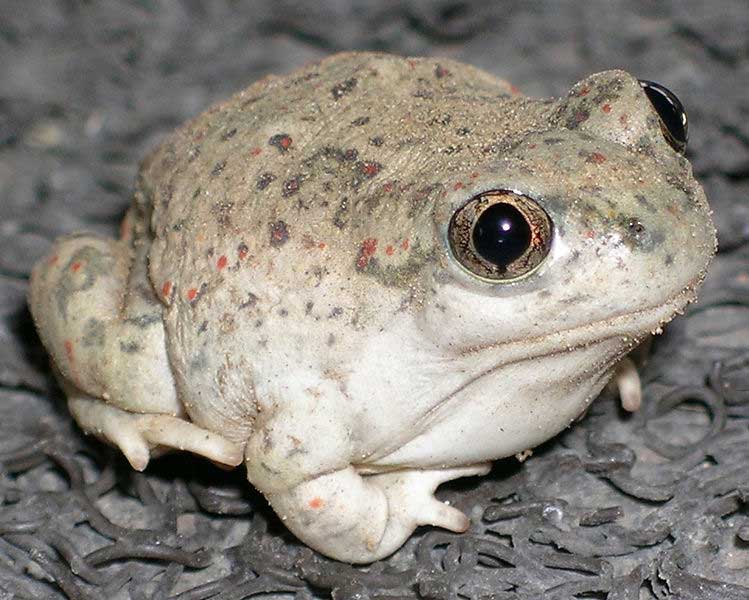
Spea multiplicata, Photo: Sarah Beckwith, nps.gov
Superregnum: Eukaryota
Regnum: Animalia
Subregnum: Eumetazoa
Cladus: Bilateria
Cladus: Nephrozoa
Superphylum: Deuterostomia
Phylum: Chordata
Cladus: Craniata
Subphylum: Vertebrata
Infraphylum: Gnathostomata
Superclassis: Tetrapoda
Classis: Amphibia
Subclassis: Lissamphibia
Ordo: Anura
Familia: Scaphiopodidae
Genus: Spea
Species: Spea multiplicata
Name
Spea multiplicata (Cope, 1863)
Type locality: "Valley of Mexico".
Holotype: USNM 3694.
Synonyms
Scaphiopus multiplicatus Cope, 1863
Spea multiplicata — Cope, 1866
Spea stagnalis Cope in Yarrow, 1875
Scaphiopus dugesi Brocchi, 1879
Scaphiopus multiplicatus — Boulenger, 1882
Scaphiopus stagnalis — Boulenger, 1882
Scaphiopus hammondii multiplicatus — Kellogg, 1932
Spea hammondii multiplicata — Firschein, 1950
Spea multiplicata — Taylor, 1952
Scaphiopus (Spea) multiplicatus — Dubois, 1987
Spea hammondi stagnalis — Tanner, 1989
Spea hammondi multiplicata — Tanner, 1989
Spea hammondii stagnalis — Tanner, 1989
Spea multiplicata — Wiens & Titus, 1991
References
Cope, 1863, Proc. Acad. Nat. Sci. Philadelphia, 15: 52.
Kellogg, R. 1932. Mexican tailless amphibians in the United States National Museum. Bulletin of the United States National Museum 160: 1–224. DOI: 10.5479/si.03629236.160.i. BHL. Reference page.
Wiens and Titus, 1991, Herpetologica, 47: 21–28.
Frost, D.R. 2021. Amphibian Species of the World: an Online Reference. Version 6.1. Electronic Database accessible at https://amphibiansoftheworld.amnh.org/index.php. American Museum of Natural History, New York, USA. DOI: 10.5531/db.vz.0001 Spea multiplicata . Accessed on 13 July 2008.
2007 IUCN Red List of Threatened Species IUCN: Spea multiplicata (Least Concern) Downloaded on 13 July 2008.
Vernacular names
English: New Mexico Spadefoot Toad
polski: Łopatonóg meksykański
The New Mexico spadefoot toad (Spea multiplicata) is a species of American spadefoot toad found in the southwestern United States and Mexico. Like other species of spadefoot toad, they get their name from a distinctive spade-like projections on their hind legs which enable them to dig in sandy soils. Spea multiplicata can be identified by its wedge-shaped spade. Some sources also refer to the species as the Mexican spadefoot toad, desert spadefoot toad or southern spadefoot toad.
Description
The New Mexico spadefoot toad grows from 1.5 to 2.5 inches in length, and has a round body, with relatively short legs. They are green, to grey, to brown, usually reflecting the soil color of their native habitat, often with black and orange colored speckling on their back, and a white underside. They have large eyes, with vertical pupils.
Behavior
Like all species of spadefoot toad, the New Mexico spadefoot toad is nocturnal and secretive. If handled, these frogs might emit a peanutlike odor, which can cause tearing and nasal discharge if in close contact with the face. Spending most of its time buried in the ground, the spadefoot emerges during periods of summer rainfall to feed on insects and to breed. Breeding takes place in temporary pools left by the rain. Eggs laid in large masses, often hatch in as little as 48 hours. The tadpoles are forced to metamorphose quickly, before the water dries up. S. multiplicata tadpoles exhibit phenotypic plasticity. Tadpoles that ingest fairy shrimp, when present, may express a novel carnivore phenotype. This novel phenotype increases the rate of development, helping the tadpoles to escape drying ponds more rapidly.[1]
Taxonomy
The species was once classified as a subspecies of the western spadefoot toad, Spea hammondii, but distinctive morphological characteristics led researchers to reclassify it as its own species. The New Mexico spadefoot toad is also known to hybridize with the Plains spadefoot toad, Spea bombifrons in the areas where their ranges overlap, making distinguishing the species from each other difficult.
Trivia
The New Mexico spadefoot toad was designated as the official State Amphibian of New Mexico in 2003.
References
Pfennig, David (1990). "The adaptive significance of an environmentally-cued developmental switch in an anuran tadpole". Oecologia. 85: 101–107. doi:10.1007/bf00317349.
Herps of Texas: Spea multiplicata
Amphibian Species of the World: Spea multiplicata
Peterson Field Guide - Western Reptiles and Amphibians 3rd Edition
Retrieved from "http://en.wikipedia.org/"
All text is available under the terms of the GNU Free Documentation License

